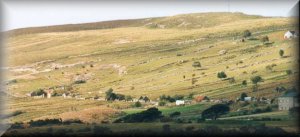Crofting
Past and Present Day Crofting in Ullapool
Crofting: History and Present
by George Campbell in “A guide to Ullapool”

Crofting is a unique form of land tenure, and though there are similarities with other small farming systems throughout Europe, it has no exact replica.
The History of Crofting
Crofting as we know it today, is located in the peripheral areas representing some of the poorest and most disadvantaged agricultural land in Europe. However, the crofting communities did not inhabit these areas by accident, but rather by a series of events which culminated in what today are known as the “highland Clearances.”
The demise of the traditional land ownership structure was closely linked to the destruction of the clan system after the defeat of the Jacobite rising. The dismantling of the clan system led to problems such as over-population, due primarily to excessive subdivisions of holdings. These man-made problems were exacerbated by natural disaters such as the potato famine, which resulted in mass emigration to Canada and Australia.
These voluntary emigrants were often accompanied by whole communities who had been forcibly cleared off their land to make way for more profitable or desirable enterprises such as sheep farming and sporting estates. Towards the end of the 19th Century there were a number of noted battles involving crofters against landlords who were attempting to deny them their traditional rights. The land battles, often involving women and elderly people, attracted attention and public concern was such that a Commission was appointed to look into the whole issue of crofting.
The resulting Napier Commission report made a number of recommendations, the most important of which was a need for new legislation, which would give crofters security of tenure. Thus the first Crofting Act was passed in 1886 and essentially gave crofters security of tenure and also the right of compensation for any improvements carried out by them. The first crofts were created in 1886 but there was still an immense demand for land, and land raids (the forcible acquisition of land) continued until after the Second World War. So throughout the first half of the 20th century further crofts were created, mostly on land acquired by the Department of Agriculture. So the legal definition of a croft as opposed to a smallholding is that it must have been registered as a croft under the 1886 or subsequent Crofting Acts. But what is the practical difference?
Crofting Today
There are 17000 registered crofts in the Highlands and Islands and these are concentrated on the North and West coasts and the Islands which lie in that seaboard such as Shetland in the North to Mull and Tiree in the South. There is no specific size for a croft – it very much depends on the physical nature of the landscape of the area in which any one crofting township is located. However, despite these differences all crofts have similarities in that they are operating in the most physically disadvantaged areas, with atrocious weather conditions coupled with distance from markets etc. Most crofting agriculture is based on the production of store sheep and cattle, which are then sold on to be finished elsewhere in the U.K.
Crofting is as much a way of life as an economic or physical activity. The Crofting Township is unique because it is both collaborative and individualistic. The township committee allocates common grazings, sets dates for communal shearing and dipping of sheep, arranges for the visit of the bull and may share the costs of a new piece of equipment. But individual’s manage the croft as a sole tenant and may try new ideas or dispense with old ones according to what they wish for themselves and their families. Without collaboration the communities could not survive – without individualism they would not want to. But, cofting, both individually and collectively, is constrained by external factors because crofting is not full-time agriculture – it was never intended to be. The principle constraint is the availability of additional income.
There are some full-time crofters earning their entire living from agriculture, but these are the minority. Most crofters require another occupation, sometimes several part-time occupations, and sometimes just one main job.
Thus we see in the delicate balance of crofting, not only its dependence on the agricultural economy, but even more importantly on the health of the
wider Highland economy.
Use the menu below for a walk through the past history of Ullapool. If there is anything you would like to add or if indeed you have some old photos of Ullapool and its people we would love to hear from you.
| Before 1788 Ullapool Clock Pipe Band |
Fishing Industry Crofting Isle Martin |
Clearances Archaeology Landscape |